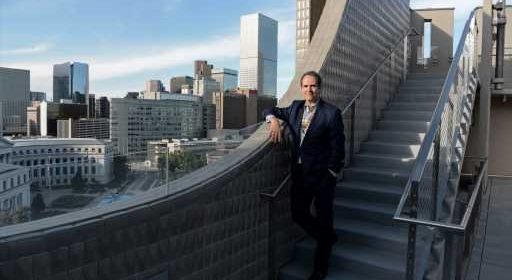Inside Denver Art Museum’s $175 million makeover, which opens this month

Inside the brightly lit lobby of Denver Art Museum’s Sie Welcome Center last week, Christoph Heinrich fretted over a speech to donors.
“It’s already half an hour long,” the museum’s director said of his Wednesday, Oct. 13, address, which heralds $175 million in upgrades and additions at the institution. “It really is a complete overhaul and redefinition of the museum, so it’s hard to fit in all the details.”
As Heinrich, 61, stood in the lobby, employees hurried by toting ladders and wires and buckets of paint, a reminder that there was still work to be done. But it was merely detail work: The ambitious project — which added the Sie Welcome Center and 35,000 square feet to the museum’s iconic, 50-year-old North Building — had finally been realized.
Now called the Lanny and Sharon Martin Building, the gray-tiled tower was designed by Italian architect Gio Ponti and opened in 1971. It was due for a major overhaul and preservation, Heinrich said, and received one, thanks to Denver’s voter-approved bond issue in 2017, which covered $35.5 million in infrastructure upgrades — and jumpstarted fundraising for the larger project.
The public will be able to explore the renovated Martin Building, along with the 50,000-square-foot Sie Welcome Center, during Denver Art Museum’s free reopening festivities on Oct. 24.
The renovation essentially doubled the museum’s public gallery space, reintroducing visitors to its famed North American Indigenous, Asian-Pacific, Western Art and Latin American collections while highlighting textiles, contemporary design, photography and more.
The Sie, in particular, invites reassessment. It shifts the visual balance of the complex from two main buildings to its own, spaceship-like façade of floor-to-ceiling windows. The airy public space also features classrooms and play areas for the tens of thousands of students who visit each year; a restaurant helmed by James Beard Award-winner Jennifer Jasinski; a café; and a ballroom-for-rent.
Just south of the new and renovated spaces at 1400 W. 14th Parkway sits the other half of the art museum complex: architect Daniel Libeskind’s sharp, silvery Hamilton building, which was completed in 2006 and reopened for several months last year.
Now, after three years of work and last year’s pandemic delays, the museum’s public face is ready. It’s a milestone for Denver’s art scene, but it’s not the only one. Major anniversaries this year for the Museum of Contemporary Art Denver (at 25 years) and the Clyfford Still Museum (10 years) join the reopening of Denver’s Kirkland Museum after extensive water damage in February (officials saved the majority of works).
“What’s exciting about the reopening is that it shows how this city has invested in art as an economic driver, and as something that knits our communities together,” said Joyce Tsai, director of the Clyfford Still Museum, Denver Art Museum’s next-door neighbor in the Golden Triangle Creative District. “In the face of the pandemic, the cultural sector has become more focused on sharing successes than competing.”
That’s significant, as a full-strength Denver Art Museum has the potential to goose the Golden Triangle’s slow foot traffic. Over the past 18 months, the area has been besieged by the same protests, homeless camps and vandalism that have largely hollowed out central downtown’s corridors.
“I am excited about the reopening,” wrote Jennifer Larsen, a Golden Triangle resident and assistant at its Creative District, via email. “Our museums and galleries bring people into the neighborhood (who) often stay for a meal or a drink, or to explore other offerings.”
Denver Art Museum, one of the metro area’s top cultural attractions, has averaged about 800,000 visitors annually in recent years, according to Heinrich. When he started his job in 2010, the museum welcomed about 100,000 annual attendees. The growth is good, but it presents problems, Heinrich said.
“The city is changing and becoming more dense and gentrified,” he said as he looked down on a shuttered Civic Center park from the roof of the Martin Building. “But more people can mean more support for the arts.”
That was borne out in the museum’s capital campaign over the last three years, which was supported by a pair of surprise, $25 million donations — one from the Martins, another from an anonymous benefactor. That helped fund an energy-efficient makeover, which found workers stripping materials down to the Martin building’s original walls. They filled in lofted spaces with wooden floors, and added newly built rooms on the roof of the seven-story building.
The retooling also is a restoration of some of Ponti’s original design elements, with motifs that bow or conform to his cut-out, geometric silhouettes. Stately but approachable design has lowered some objects to within touching distance in the eclectic galleries, their walls splashed with vibrant reds and cool greens.
“I’m not sure I would have wanted to do this if I knew it was going to cost $175 million,” Heinrich said with a laugh while standing next to a 22-foot-tall Haida totem pole, dated to 1870. “It’s good that we didn’t know that back then.”
Subscribe to our weekly newsletter, In The Know, to get entertainment news sent straight to your inbox.
Source: Read Full Article



